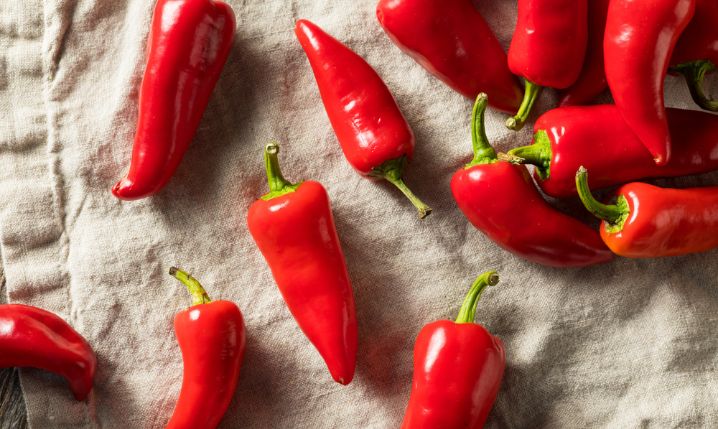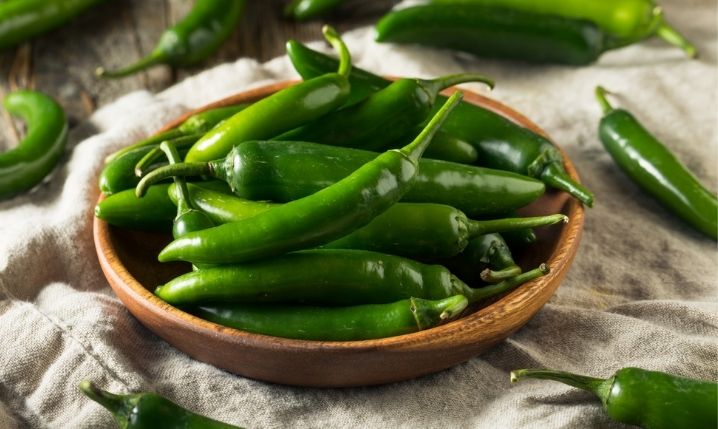There are so many peppers that it is sometimes difficult to understand their differences. In this article, we’re comparing two chili peppers that are often recommended as substitution options for one another. Read on to find out what you need to know when comparing the Fresno pepper vs. serrano pepper.
Contents:
What Are Fresno Peppers?

The Fresno Pepper is a type of chili pepper from New Mexico, USA. It was first cultivated in 1952, when it was named after the City of Fresno, California, by Clarence Brown Hamlin.
Fresno peppers are most often sold mature (red) and have a fruity, smoky taste. The less mature (green) Fresno peppers have a brighter, grassier taste that is often likened to a jalapeño.
Fresno peppers have a Scoville heat unit rating between 2,500-10,000 with a median SHU of 6,250.
With a conical shape, around 2 inches long with thick walls and a rough diameter of an inch, these peppers are small-medium in size.
You can use Fresno peppers for pickling, stuffing, salsas, hot sauces, ceviche, rice and bean dishes, and more.
What Are Serrano Peppers?

Serrano peppers are medium-heat chilies that originated in the Puebla region of Mexico. Today, they’re grown in both Mexico and the United States.
Young serrano peppers have a bright, grassy flavor to them, but when they mature and start to redden, they have a much smokier bite than the younger, green serrano peppers.
With a rating between 10,000 – 23,000 SHU, it gives them a median heat rating of 16,500, making them a medium-heat chili, but many would find these peppers hot.
Serrano peppers are approximately 2-4 inches long, they have a noticeable curve compared to some chilies, and the wall cavity isn’t too thick, making them good for salsas but not so good for stuffing.
You can use serrano peppers for salads, soups, sandwiches, salsas, stews, and even as a side dish.
What’s The Difference Between Fresno Peppers and Serrano Peppers?
| Fresno Pepper | Serrano Pepper |
|---|---|
| 2,500 – 10,000 Scoville heat units (SHU) | 10,000 – 23,000 Scoville heat units (SHU) |
| Bright, Grassy, Fruity, Smoky | Bright, Grassy, Smoky |
| 2 inches long with thick cavity walls | 2-4 inches long with thin cavity walls |
| Originally from the United States | Originally from Mexico |
There are a few important differences between Fresno and serrano peppers that you should know about. Let’s review some of the ones that can make the biggest difference in this culinary showdown.
Besides the heat levels, the flavors can differ because of the maturation point of the chili. Fresno peppers are often used when mature, visually having a red color, and that’s when they have the famous fruitiness and smokiness that people love. Meanwhile, serrano peppers can achieve a smokier flavor, but also when mature. The issue is that serrano peppers are most used when less mature, which is when they look green, not red.
In addition to the taste differences, there are some slight size and texture differences. Fresno peppers have thick walls that make them moderately suitable for stuffing (they’d be better suited if they were bigger peppers), but serrano peppers have thin walls that make them less suited to stuffing.
Despite the differences, they’re often recommended as substitutes for one another as they are used in similar dishes and can have similar flavors. Usually, you’d use less serrano when using it in place of Fresno pepper unless you wanted the extra heat. Neither of the two peppers is recommended for drying purposes.
- Size: Fresno peppers are around 2 inches long with a typical conical shape. Serrano peppers are between 2-4 inches long with a curved shape.
- Appearance: You will often purchase Fresno peppers when they are mature (red), whereas serrano peppers are often purchased before they mature (green).
- Taste and texture: Both of these peppers can have a bright, grassy bite, though typically, Fresno peppers are sold when mature, which gives them a smoky, fruity flavor. Because of their thick walls, Fresno peppers are also a bit chewier than serrano peppers.
- Culinary uses: Both of these peppers are used for salsas, hot sauces, side dishes, and more. Due to texture differences, Serrano peppers are a little more suited to salsas, while Fresno peppers are more suited to stuffing. Both are used for pickling uses.
Conclusion
Now you know all you need to compare Fresno peppers to serrano peppers. They have similar flavors that mostly vary because of the maturity level they’re recommended to be used at. The texture differences are noticeable, as are the heat differences, serrano peppers being much hotter than Fresno peppers. Despite the differences, they make great substitutes for one another in many situations, so long as you know their characteristics.